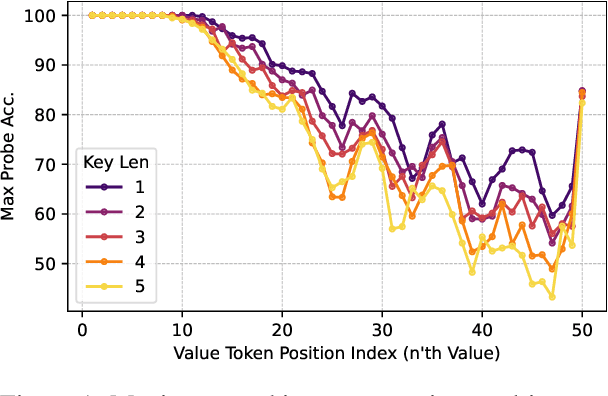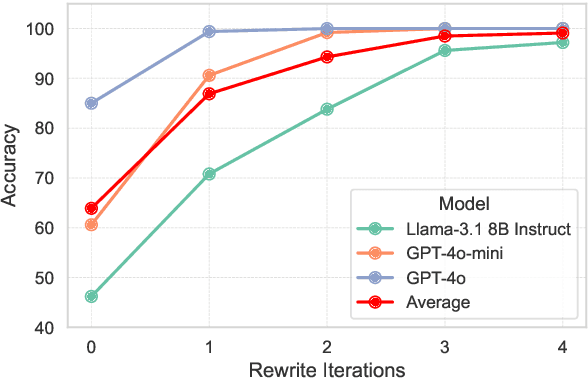Suyuchen Wang
Advances and Challenges in Foundation Agents: From Brain-Inspired Intelligence to Evolutionary, Collaborative, and Safe Systems
Mar 31, 2025Abstract:The advent of large language models (LLMs) has catalyzed a transformative shift in artificial intelligence, paving the way for advanced intelligent agents capable of sophisticated reasoning, robust perception, and versatile action across diverse domains. As these agents increasingly drive AI research and practical applications, their design, evaluation, and continuous improvement present intricate, multifaceted challenges. This survey provides a comprehensive overview, framing intelligent agents within a modular, brain-inspired architecture that integrates principles from cognitive science, neuroscience, and computational research. We structure our exploration into four interconnected parts. First, we delve into the modular foundation of intelligent agents, systematically mapping their cognitive, perceptual, and operational modules onto analogous human brain functionalities, and elucidating core components such as memory, world modeling, reward processing, and emotion-like systems. Second, we discuss self-enhancement and adaptive evolution mechanisms, exploring how agents autonomously refine their capabilities, adapt to dynamic environments, and achieve continual learning through automated optimization paradigms, including emerging AutoML and LLM-driven optimization strategies. Third, we examine collaborative and evolutionary multi-agent systems, investigating the collective intelligence emerging from agent interactions, cooperation, and societal structures, highlighting parallels to human social dynamics. Finally, we address the critical imperative of building safe, secure, and beneficial AI systems, emphasizing intrinsic and extrinsic security threats, ethical alignment, robustness, and practical mitigation strategies necessary for trustworthy real-world deployment.
R$^3$Mem: Bridging Memory Retention and Retrieval via Reversible Compression
Feb 21, 2025Abstract:Memory plays a key role in enhancing LLMs' performance when deployed to real-world applications. Existing solutions face trade-offs: explicit memory designs based on external storage require complex management and incur storage overhead, while implicit memory designs that store information via parameters struggle with reliable retrieval. In this paper, we propose R$^3$Mem, a memory network that optimizes both information Retention and Retrieval through Reversible context compression. Specifically, R$^3$Mem employs virtual memory tokens to compress and encode infinitely long histories, further enhanced by a hierarchical compression strategy that refines information from document- to entity-level for improved assimilation across granularities. For retrieval, R$^3$Mem employs a reversible architecture, reconstructing raw data by invoking the model backward with compressed information. Implemented via parameter-efficient fine-tuning, it can integrate seamlessly with any Transformer-based model. Experiments demonstrate that our memory design achieves state-of-the-art performance in long-context language modeling and retrieval-augmented generation tasks. It also significantly outperforms conventional memory modules in long-horizon interaction tasks like conversational agents, showcasing its potential for next-generation retrieval systems.
AlignVLM: Bridging Vision and Language Latent Spaces for Multimodal Understanding
Feb 03, 2025



Abstract:Aligning visual features with language embeddings is a key challenge in vision-language models (VLMs). The performance of such models hinges on having a good connector that maps visual features generated by a vision encoder to a shared embedding space with the LLM while preserving semantic similarity. Existing connectors, such as multilayer perceptrons (MLPs), often produce out-of-distribution or noisy inputs, leading to misalignment between the modalities. In this work, we propose a novel vision-text alignment method, AlignVLM, that maps visual features to a weighted average of LLM text embeddings. Our approach leverages the linguistic priors encoded by the LLM to ensure that visual features are mapped to regions of the space that the LLM can effectively interpret. AlignVLM is particularly effective for document understanding tasks, where scanned document images must be accurately mapped to their textual content. Our extensive experiments show that AlignVLM achieves state-of-the-art performance compared to prior alignment methods. We provide further analysis demonstrating improved vision-text feature alignment and robustness to noise.
BigDocs: An Open and Permissively-Licensed Dataset for Training Multimodal Models on Document and Code Tasks
Dec 05, 2024



Abstract:Multimodal AI has the potential to significantly enhance document-understanding tasks, such as processing receipts, understanding workflows, extracting data from documents, and summarizing reports. Code generation tasks that require long-structured outputs can also be enhanced by multimodality. Despite this, their use in commercial applications is often limited due to limited access to training data and restrictive licensing, which hinders open access. To address these limitations, we introduce BigDocs-7.5M, a high-quality, open-access dataset comprising 7.5 million multimodal documents across 30 tasks. We use an efficient data curation process to ensure our data is high-quality and license-permissive. Our process emphasizes accountability, responsibility, and transparency through filtering rules, traceable metadata, and careful content analysis. Additionally, we introduce BigDocs-Bench, a benchmark suite with 10 novel tasks where we create datasets that reflect real-world use cases involving reasoning over Graphical User Interfaces (GUI) and code generation from images. Our experiments show that training with BigDocs-Bench improves average performance up to 25.8% over closed-source GPT-4o in document reasoning and structured output tasks such as Screenshot2HTML or Image2Latex generation. Finally, human evaluations showed a preference for outputs from models trained on BigDocs over GPT-4o. This suggests that BigDocs can help both academics and the open-source community utilize and improve AI tools to enhance multimodal capabilities and document reasoning. The project is hosted at https://bigdocs.github.io .
FACT: Examining the Effectiveness of Iterative Context Rewriting for Multi-fact Retrieval
Oct 28, 2024



Abstract:Large Language Models (LLMs) are proficient at retrieving single facts from extended contexts, yet they struggle with tasks requiring the simultaneous retrieval of multiple facts, especially during generation. This paper identifies a novel "lost-in-the-middle" phenomenon, where LLMs progressively lose track of critical information throughout the generation process, resulting in incomplete or inaccurate retrieval. To address this challenge, we introduce Find All Crucial Texts (FACT), an iterative retrieval method that refines context through successive rounds of rewriting. This approach enables models to capture essential facts incrementally, which are often overlooked in single-pass retrieval. Experiments demonstrate that FACT substantially enhances multi-fact retrieval performance across various tasks, though improvements are less notable in general-purpose QA scenarios. Our findings shed light on the limitations of LLMs in multi-fact retrieval and underscore the need for more resilient long-context retrieval strategies.
LongRecipe: Recipe for Efficient Long Context Generalization in Large Language Models
Sep 04, 2024Abstract:Large language models (LLMs) face significant challenges in handling long-context tasks because of their limited effective context window size during pretraining, which restricts their ability to generalize over extended sequences. Meanwhile, extending the context window in LLMs through post-pretraining is highly resource-intensive. To address this, we introduce LongRecipe, an efficient training strategy for extending the context window of LLMs, including impactful token analysis, position index transformation, and training optimization strategies. It simulates long-sequence inputs while maintaining training efficiency and significantly improves the model's understanding of long-range dependencies. Experiments on three types of LLMs show that LongRecipe can utilize long sequences while requiring only 30% of the target context window size, and reduces computational training resource over 85% compared to full sequence training. Furthermore, LongRecipe also preserves the original LLM's capabilities in general tasks. Ultimately, we can extend the effective context window of open-source LLMs from 8k to 128k, achieving performance close to GPT-4 with just one day of dedicated training using a single GPU with 80G memory. Our code is released at https://github.com/zhiyuanhubj/LongRecipe.
MAP: Low-compute Model Merging with Amortized Pareto Fronts via Quadratic Approximation
Jun 11, 2024



Abstract:Model merging has emerged as an effective approach to combine multiple single-task models, fine-tuned from the same pre-trained model, into a multitask model. This process typically involves computing a weighted average of the model parameters without any additional training. Existing model-merging methods focus on enhancing average task accuracy. However, interference and conflicts between the objectives of different tasks can lead to trade-offs during model merging. In real-world applications, a set of solutions with various trade-offs can be more informative, helping practitioners make decisions based on diverse preferences. In this paper, we introduce a novel low-compute algorithm, Model Merging with Amortized Pareto Front (MAP). MAP identifies a Pareto set of scaling coefficients for merging multiple models to reflect the trade-offs. The core component of MAP is approximating the evaluation metrics of the various tasks using a quadratic approximation surrogate model derived from a pre-selected set of scaling coefficients, enabling amortized inference. Experimental results on vision and natural language processing tasks show that MAP can accurately identify the Pareto front. To further reduce the required computation of MAP, we propose (1) a Bayesian adaptive sampling algorithm and (2) a nested merging scheme with multiple stages.
VCR: Visual Caption Restoration
Jun 10, 2024



Abstract:We introduce Visual Caption Restoration (VCR), a novel vision-language task that challenges models to accurately restore partially obscured texts using pixel-level hints within images. This task stems from the observation that text embedded in images is intrinsically different from common visual elements and natural language due to the need to align the modalities of vision, text, and text embedded in images. While numerous works have integrated text embedded in images into visual question-answering tasks, approaches to these tasks generally rely on optical character recognition or masked language modeling, thus reducing the task to mainly text-based processing. However, text-based processing becomes ineffective in VCR as accurate text restoration depends on the combined information from provided images, context, and subtle cues from the tiny exposed areas of masked texts. We develop a pipeline to generate synthetic images for the VCR task using image-caption pairs, with adjustable caption visibility to control the task difficulty. With this pipeline, we construct a dataset for VCR called VCR-Wiki using images with captions from Wikipedia, comprising 2.11M English and 346K Chinese entities in both easy and hard split variants. Our results reveal that current vision language models significantly lag behind human performance in the VCR task, and merely fine-tuning the models on our dataset does not lead to notable improvements. We release VCR-Wiki and the data construction code to facilitate future research.
Resonance RoPE: Improving Context Length Generalization of Large Language Models
Feb 29, 2024Abstract:This paper addresses the challenge of train-short-test-long (TSTL) scenarios in Large Language Models (LLMs) equipped with Rotary Position Embedding (RoPE), where models pre-trained on shorter sequences face difficulty with out-of-distribution (OOD) token positions in longer sequences. We introduce Resonance RoPE, a novel approach designed to narrow the generalization gap in TSTL scenarios by refining the interpolation of RoPE features for OOD positions, significantly improving the model performance without additional online computational costs. Furthermore, we present PosGen, a new synthetic benchmark specifically designed for fine-grained behavior analysis in TSTL scenarios, aiming to isolate the constantly increasing difficulty of token generation on long contexts from the challenges of recognizing new token positions. Our experiments on synthetic tasks show that after applying Resonance RoPE, Transformers recognize OOD position better and more robustly. Our extensive LLM experiments also show superior performance after applying Resonance RoPE to the current state-of-the-art RoPE scaling method, YaRN, on both upstream language modeling tasks and a variety of downstream long-text applications.
Multimodal Multi-Hop Question Answering Through a Conversation Between Tools and Efficiently Finetuned Large Language Models
Sep 16, 2023



Abstract:We employ a tool-interacting divide-and-conquer strategy enabling large language models (LLMs) to answer complex multimodal multi-hop questions. In particular, we harness the power of large language models to divide a given multimodal multi-hop question into unimodal single-hop sub-questions to be answered by the appropriate tool from a predefined set of tools. After all corresponding tools provide the LLM with their answers, the LLM generates the next relevant unimodal single-hop question. To increase the reasoning ability of LLMs, we prompt chatGPT to generate a tool-interacting divide-and-conquer dataset. This dataset is then used to efficiently finetune the corresponding LLM. To assess the effectiveness of this approach, we conduct an evaluation on two recently introduced complex question-answering datasets. The experimental analysis demonstrate substantial improvements over existing state-of-the-art solutions, indicating the efficacy and generality of our strategy
 Add to Chrome
Add to Chrome Add to Firefox
Add to Firefox Add to Edge
Add to Edge